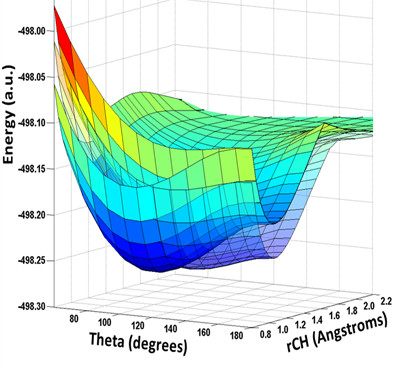Back to Publications
Silver Nyambo, Cyrus Karshenas, Scott A. Reid, Phalgun Lolur, Richard Dawes, Towards a global model of spin-orbit coupling in the halocarbenes, J. Chem. Phys. 142, 214304 (2015).
ABSTRACT: We report a global analysis of spin-orbit coupling in the mono-halocarbenes, CH(D)X, where X = Cl, Br, I. The mono-halocarbenes are model systems for examining carbene singlet-triplet energy gaps and spin-orbit coupling. Over the past decade, our group and others have used Single Vibronic Level (SVL) emission spectroscopy and Stimulated Emission Pumping (SEP) spectroscopy to probe the ground vibrational level structure in these carbenes, which has clearly demonstrated the presence of perturbations involving the low-lying triplet state for X = Cl, Br, and I. However, many levels remain unassigned, and the analysis of perturbations in these systems has largely been confined to simple two- or three-state interactions. To model these interactions more globally, we compare two approaches. First, a diabatic treatment of the spin-orbit coupling, where the coupling matrix elements are written in terms of a purely electronic spin-orbit matrix element which is independent of nuclear coordinates, and an integral representing the overlap of the singlet and triplet vibrational wavefunctions. In this way, the structures, harmonic frequencies, and normal mode displacements from ab initio calculations were used to calculate the vibrational overlaps of the singlet and triplet state levels, including the full effects of Duschinsky mixing. These results were then incorporated with the electronic spin-orbit matrix elements into a matrix diagonalization routine that calculated the term energies of the mixed singlet-triplet levels, which were iteratively fit to the extensive experimental results from SVL emission and SEP spectroscopy for the carbenes and their deuterated isotopomers. These calculations have allowed many new assignments to be made, particularly for CHI, and provided spin-orbit coupling parameters and values for the singlet-triplet gaps. Second, for comparison we have computed and fit full geometry dependent spin-orbit coupling surfaces and used them to compute matrix elements without the product form approximation. Those matrix elements were used in similar optimizations varying the anharmonic constants and singlet-triplet gap to reproduce the experimental levels. The derived spin-orbit parameters for carbenes CHX (X = Cl, Br, and I) show an excellent linear correlation with the atomic spin-orbit constant of the corresponding halogen, indicating that the spin-orbit coupling in the carbenes is consistently around 14% of the atomic value.
